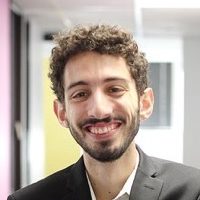Dec. 2, 2015 was an average day for San Bernardino Police Lt. Mike Madden — until it wasn’t.
On his way back to headquarters from a meeting, he pulled over to pick up a snack wrap from McDonald’s and then again to take a phone call. Then, at 10:58 a.m., the dispatch came in: shots fired at the Inland Regional Center, a county building just north of the I-10 Freeway.
Madden spends most of his days behind a desk as an administrator. He was hardly the ideal choice to be the first person on the scene of a terrorist attack.
“The biggest dangers that I have on a daily basis are generally paper cuts,” he told dozens of lay leaders, security professionals and clergy members who gathered on Aug. 23 at the Westwood office of the Anti-Defamation League (ADL).
Madden’s experience offered one of many lessons from the ADL’s annual security briefing this year: When police respond to an active shooter situation, it likely won’t be a specially trained operative who shows up first.
“It’s going to be some stupid lieutenant who almost stapled his fingers together,” Madden said. “It’s going to be a homicide detective who hasn’t been on patrol for seven years.”
This year, the ADL brought Madden and San Bernardino Police Chief Jarrod Burguan to share experiences gleaned from the terrorist attack that claimed 14 lives at a county government building there and brought the threat of terrorism home to Southern California.
The two police officials shared lessons Jewish institutions hopefully will never make use of, but might one day have to, and afforded Jewish professionals an inside look at what unfolded the day of the attack.
Burguan played a 911 call from a man who had spotted a suspicious black SUV leaving the Inland Regional Center. Arriving home, the man saw news of the shooting and phoned in, reciting the license plate number from memory: X523RY. For law enforcement, it was a lucky break.
“I’ve been a cop for 20 years,” the police chief said. “I couldn’t tell you a single license plate for any car parked outside.”
The police were able to trace the number to an Enterprise Rent-a-Car lot that had rented a black SUV to Syed Farook, who, with his wife, Tashfeen Malik, committed the shootings.
The San Bernardino tragedy was an outlier, but hardly an isolated event. Last year saw an increase in so-called targets of convenience — low-profile, random targets, often chosen to evade law enforcement and increase casualties, according to Joanna Mendelson, an investigative researcher with ADL’s Center on Extremism who introduced the two men at the August event. Overall, 2015 saw more terrorist-related arrests — 82 — than any previous year, she said.
The ADL, a hate-speech watchdog, pays close attention to terrorist attacks since they are “hate crime writ large,” Amanda Susskind, the organization’s regional director here, said at the event.
The annual briefing, held in advance of the High Holy Days, deals with timely topics in security, part of an ongoing effort by the ADL to provide police and Jewish institutions a means to protect the local community from hate-related threats.
In May, for instance, the ADL gathered 400 law enforcement officers at the West Los Angeles Veterans Affairs campus to glean lessons from the ideologically motivated attacks over the previous year, including the one in San Bernardino. Two months earlier, it awarded its annual Sherwood Prize, honoring law officers who go beyond the call of duty, to the San Bernardino Sheriff’s Department, along with the 13 other agencies that first responded to the December attack.
In its online security manual “Protecting Your Jewish Institution,” the ADL suggests that synagogues, schools and nonprofits cultivate close police relationships, as well. Last updated in 2015, the manual encourages Jewish institutions to proactively develop attack response plans that involve the community in their own protection. It includes a section on security preparations for the High Holy Days.
After all, one of the lessons from last year’s tragedy in Southern California is that nobody should consider themselves immune from the threat of terrorism, Burguan said at the event.
“I’m here to tell you: If it can happen in San Bernardino, it really can happen absolutely anywhere.”






















 More news and opinions than at a Shabbat dinner, right in your inbox.
More news and opinions than at a Shabbat dinner, right in your inbox.